Given some of the recent threads regarding PSK contents, modular kits, and various tins and wallets for holding things, I decided I'd share a somewhat novel system I've settled on (with much credit and many thanks to this forum and the Equipped site for inspiration and refinement).
Some quick background: I have a fairly diverse set of needs for survival and emergency kits. Over time, I've decided that a flexible, modular system better fits my needs than either a super-big, extensive kit, or many kits with lots of overlap.
I live in a big-city neighborhood but also am often staying in hotels in other big cities (LA, DC, NY) for my consulting business. I walk a lot - many miles at a time - at home and when traveling, and also hike and occasionally backpack. I'm an instrument-rated pilot and have flown extensively in the swath of the west coast between British Columbia and New Mexico, with lots of flights into the back country and over desolate terrain or mountains - and even a few flights across the entire US (an FAA "Wings" seminar on aviation survival was what introduced me to this site, btw). I also occasionally drive long distances, or up into the mountains, for recreation and travel. Finally, given my constant travel for business and pleasure, I've continually streamlined and cut back on what I carry while endeavoring to retain what's truly important...I just hate lugging a lot of stuff around!
In that vein, and as a quick aside before I get into the real kits, here's my "every day carry":
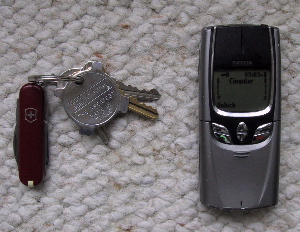
Seriously - that's it (well, except for a super-thin wallet). The small Victorinox is a model I've not been able to find any more; it has a bottle opener/wire stripper/small phillips screwdriver in addition to the usual "executive" blade, scissors and file. I like to travel light, and this small set of items takes care 99% of my daily needs, if not more. Occasionally, and where legal, I'll supplement it with a small pepper spray with a pulsar LED light on its keyring - generally if walking at night and/or in an iffy area.
OK - now on to the survival/emergency stuff.
First, here's my PSK, which usually goes in my hip pack or day pack or briefcase, though occasionally just in a pocket or on a neck chain. I take it whenever it seems prudent (which is any time I feel there's a possibility of being in anything other than a basic urban situation; this kit is appropriate as an "always on me" item all the way through the most serious risk situations such as mountain flying):
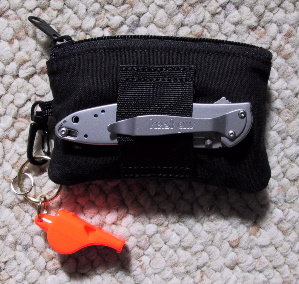
The pouch is a "Quick Change Pocket" from Eagle Creek, which I found at a local travel store. It has an outside pocket, belt loop, zippered main pocket, and a clip (suitable for adding a lanyard or breakaway neck chain in addition to the use you see here). I considered the leather wallet mentioned recently on this forum, but then came across this and decided that, for me, it's a better fit. To give you an idea of its size, here it is with an Altoids-style tin:
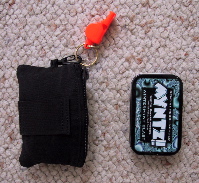
And here's what's inside it - a collection of the "modules" I was talking about:
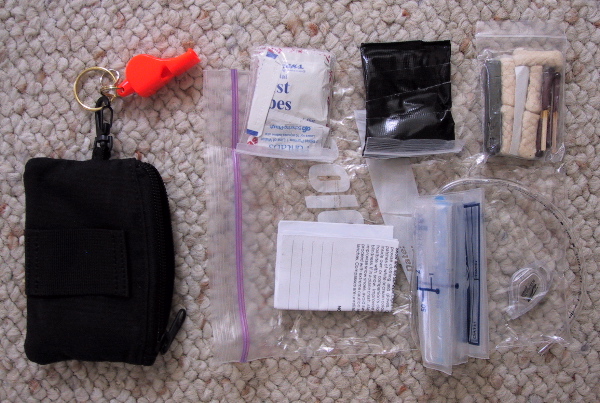
I have a module (in various ziploc bags) for each of:
- Medical (including bandaids, antiseptic wipes, analgesics, steri-strips, and water purification tablets; top left in the picture)
- Tools (including a button compass, razor blades, needles, thread/line, safety pins, a pencil stub and a couple of other odds and ends, with the pouch wrapped in electrical tape; top middle in the picture)
- Fire (including a spark-lite, sealed NATO matches, a striker (wrapped in thick cover stock), and tinder from the spark-lite; top right in the picture)
- Overall storage and water (a ziploc bag plus printed safety/survival information, a photon light, a foot of tubing and 2 Gerber water bags; the other bags go into this one and it forms a nice tight package that slips into the pouch)
That's a Fox mini-whistle clipped to the pouch for instant access. I also keep a blade or multitool for instant access in the outside pocket of the pouch, or clipped to its belt loop; any of the following will fit in that pocket:
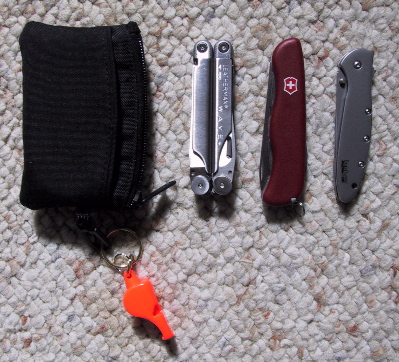
I usually carry the Leatherman Wave, as it has the most generic usefulness, though I can swap it for the Victorinox Picnicker or the Kershaw Leek depending on what seems best for a particular trip or hike.
(Yes, there is no fishing kit. I have line, and I have safety pins, and thus could improvise fishing gear - though frankly I believe it far more likely I'd walk out or be rescued long before that would become necessary.)
The modules let me quickly customize the kit; I might, for example, leave out the "Fire" stuff for a walk around town; I might take out the "Tools" and "Fire" and blade to make it legal for carry-on air travel. If I'm piloting, I'll keep everything in, put the pouch in a hip pack with the wave and the Victorinox (the Leek goes in a larger kit described below), and add a Yaesu NavCom and handheld GPS, plus (for night flying) pack a Petzl Tikka and wear a necklace with several LED lights on it (white and night vision colors, plus a backup for redundancy).
The packing system also makes it easy to get and and change contents of the modules, either to improve utility or to replace expired items. I find this suits my needs better than a sealed tin would, and am willing to live with the slight loss in protection/waterproofness of this system (which is still pretty watertight, given the multiple bags). At some point, I may shrink-wrap some of the items; there are also a few odds and ends I intend to squeeze in there, including a thin signaling mirror and a small bit of glue stick.
While this PSK fits comfortably in a pocket, I generally slip it into the inside pocket of an Arc'teryx hip pack. For a hike, I'll usually toss in a small Adventure Medical Kit (supplemented) in a zippered pouch - this goes in the hip pack along with the PSK, and gets used fairly often.
I'll not go into great detail on the larger modules, but here are a couple of pictures of what I use for flying and other serious risk situations...also suitable as a "bug-out bag". The pack I use is an Eagle Creek Bhatah Sab bag with a zippered, removable day pack and a moderate-sized main pack.
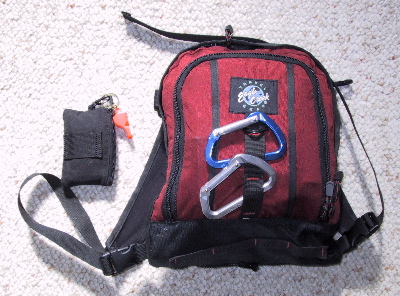
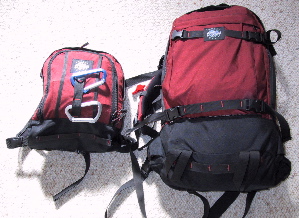
The zip-off day bag is about 10x12x8 - fairly compact, but capable of holding an immense amount of stuff. It's got a full-size FAK, a SAM splint, more blades and a sharpener, more firestarting materials and methods, a larger LED flashlight, a strobe and extra battery, a signaling mirror, another whistle plus a compass/thermometer, carabiners, a small amount of food (energy bars and hard candy), heavy-duty garbage bags and aluminum foil, rope and cord, space blankets, an Exstream water purifier bottle, bug and sun block, a SAS mini-survival-book, a compact gear repair pouch (including glue stick, cable ties, mesh, duct tape, etc.) and several other items. The contents, just as with the PSK, are subdivided into small bags (ziploc or mesh) that create modules I can mix and match as needed.
This bag goes with me whenever I fly outside the immediate area in a small plane, and in the car whenever I drive out into the country or long-distance on the highway. In all cases I'll also bring the hip pack with appropriate add-ins including the PSK and small FAK.
The large, main bag holds additional items - bottles of water, larger shelter (tarp with bright fluorescent color, rope), an esbit stove and other cooking items, more firestarting stuff, additional food bags, work gloves, and other swappable modules (e.g., a winter/cold mountain flying bag with chemical hand-warmers, gloves, hat and other relevant cold-weather items). I often add a sleeping bag, compact tent, clothing or other items appropriate to the situation at hand. This bag goes with me for serious flying over rough or remote terrain, and on long-distance drives through remote areas.
I find it takes just a minute or so to swap and organize modules if that's needed, though most of the time everything stays in each bag, ready to go for a typical trip or as a bug-out-bag.
So, that's it - at least for an overview. Thanks again to the group for all of the ideas and inspiration - hope something in this posting provides the same to some of you, and I'll look forward to feedback and suggestions.